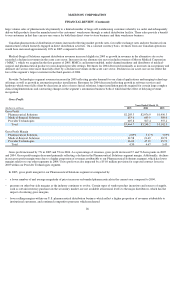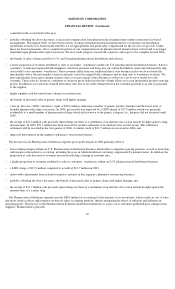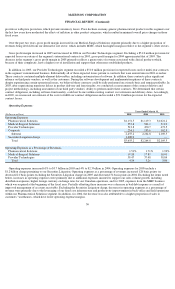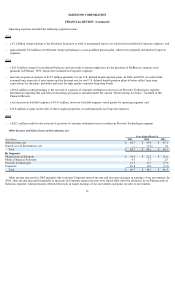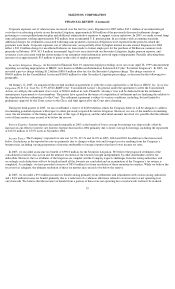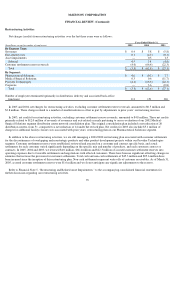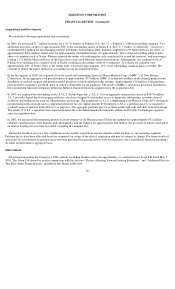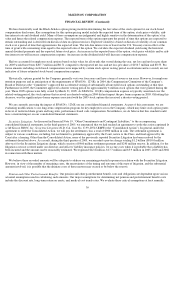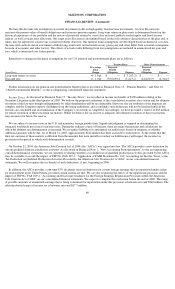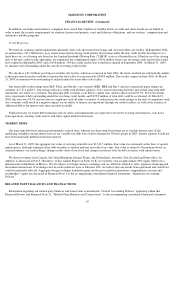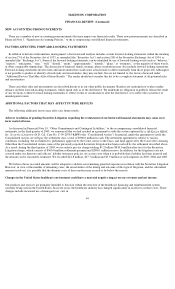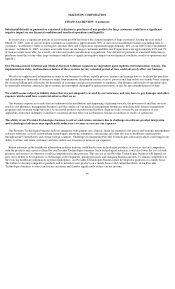McKesson 2005 Annual Report Download - page 37
Download and view the complete annual report
Please find page 37 of the 2005 McKesson annual report below. You can navigate through the pages in the report by either clicking on the pages listed below, or by using the keyword search tool below to find specific information within the annual report.
McKESSON CORPORATION
FINANCIAL REVIEW (Continued)
CRITICAL ACCOUNTING POLICIES AND ESTIMATES
We consider an accounting estimate to be critical if the estimate requires us to make assumptions about matters that were uncertain at the
time the accounting estimate was made and if different estimates that we reasonably could have used in the current period, or changes in the
accounting estimate that are reasonably likely to occur from period to period, would have a material impact on our financial condition or results
from operations. Below are the estimates that we believe are critical to the understanding of our operating results and financial condition. Other
accounting policies are described in Financial Note 1, “Significant Accounting Policies,” to our consolidated financial statements. Because of
the uncertainty inherent in such estimates, actual results may differ from these estimates.
Valuation of Receivables: We provide short-term credit and other customer financing arrangements to customers who purchase our products
and services. Other customer financing relates to guarantees provided to our customers, or their creditors, regarding the repurchase of
inventories, and lease and credit financing. We estimate the receivables for which we do not expect full collection based on historical collection
rates and specific knowledge regarding the current creditworthiness of our customers. An allowance is recorded in our consolidated financial
statements for these amounts.
If the frequency and severity of customer defaults due to our customers’ financial condition or general economic conditions change, our
allowance for uncollectible accounts may require adjustment. As a result, we continuously monitor outstanding receivables and other customer
financing and adjust allowances for accounts where collection may be in doubt. At March 31, 2005, trade and notes receivables were
$5,492.2 million, and other customer financing was $189.8 million, prior to allowances of $159.5 million.
In addition, at March 31, 2005, we had $44.9 million of notes receivable from certain of our current and former officers and senior
managers related to purchases of common stock under our various employee stock purchase plans. These notes were issued for amounts equal
to the market value of the stock on the date of the purchase, are full recourse to the borrower and were due at various dates through
February 2004. As of March 31, 2005, the value of the underlying stock collateral was $23.8 million. We evaluate the collectability of these
notes on an ongoing basis. As a result, in 2004, we recorded a $21.0 million charge for notes due from former employees whose uncollected
balances relate to the purchase of the Company’s common stock primarily in February 1999. In 2005, we reversed approximately $6 million of
this reserve based on an increase in price of the underlying stock collateral. There can be no assurance that we will recover the full amounts
due under any of the notes and we continue to assess their collectability.
Valuation of Inventories: We state inventories at the lower of cost or market. Inventories for our Pharmaceutical Solutions and Medical-
Surgical Solutions segments consist of merchandise held for resale. For our Pharmaceutical Solutions segment, the majority of the cost of
domestic inventories was determined on the LIFO method and international inventories are stated using the first-in, first-out (“FIFO”) method.
Cost of inventories for our Medical-Surgical Solutions segment was primarily determined on the FIFO method. Provider Technologies
segment’s inventories consist of computer hardware with cost determined either by the specific identification or the FIFO method. Total
inventories were $7.5 billion and $6.7 billion at March 31, 2005 and 2004. In determining whether inventory valuation issues exist, we
consider various factors including estimated quantities of slow-moving inventory by reviewing on-hand quantities, outstanding purchase
obligations and forecasted sales. Shifts in market trends and conditions, changes in customer preferences due to the introduction of generic
drugs or new pharmaceutical products, or the loss of one or more significant customers are factors that could affect the value of our inventories.
Valuation of Goodwill: We have significant goodwill assets as a result of acquiring businesses. We account for goodwill under Statement of
Financial Accounting Standards (“SFAS”) No. 142, “Goodwill and Other Intangible Assets,” which requires us to maintain goodwill assets on
our books unless the assets are deemed to be impaired. We perform an impairment test on goodwill balances annually or when indicators of
impairment exist. Such impairment tests require that we first compare the carrying value of net assets to the estimated fair value of net assets
for the operations in which goodwill is assigned. If carrying value exceeds fair value, a second step would be performed to calculate the
amount of impairment. Fair values can be determined using income, market or cost approaches.
37



